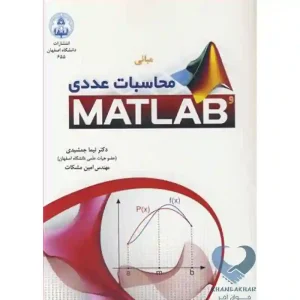
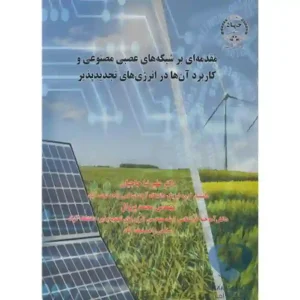
Field & Wave Electromagnetics
110,000 تومان Original price was: 110,000 تومان.105,000 تومانCurrent price is: 105,000 تومان.
ناشر: انتشارات نوپردازان<br />نویسنده: David K. Cheng
تاریخ چاپ: سوم 1389
درباره کتاب Field & Wave Electromagnetics
کتاب Field & Wave Electromagnetics تالیف David K. Cheng توسط انتشارات نوپردازان به چاپ رسیده است.
علاقمندان و دانشجویان رشته مهندسی برق میتوانند این کتاب و سایر کتاب های مرتبط را از سایت خوان آخر تهیه نمایند.
فهرست کلی مطالب کتاب
Cover
Title
Preface
Contents
1 The Electromagnetic Model
1-1 Introduction
1-2 The Electromagnetic Model
1-3 SI Units and Universal Constants
Review Questions
2 Vector Analysis
2-1 Introduction
2-2 Vector Addition and Subtraction
2-3 Products of Vectors
2-3.1 Scalar or Dot Product
2-3.2 Vector or Cross Product
2-3.3 Product of Three Vectors
2-4 Orthogonal Coordinate Systems
2-4.1 Cartesian Coordinates
2-4.2 Cylindrical Coordinates
2-4.3 Spherical Coordinates
2-5 Integrals Containing Vector Functions
2-6 Gradient of a Scalar Field
2-7 Divergence of a Vector Field
2-8 Divergence Theorem
2-9 Curl of a Vector Field
2-10 Stokes’s Theorem
2-11 Two Null Identities
2-11.1 Identity I
2-11.2 Identity II
2-12 Helmholtz’s Theorem
Review Questions
Problems
3 Static Electric Fields
3-1 Introduction
3-2 Fundamental Postulates of Electrostatics in Free Space
3-3 Coulomb’s Law
3-3.1 Electric Field Due to a System of Discrete Charges
3-3.2 Electric Field Due to a Continuous Distributionof Charge
3-4 Gauss’s Law and Applications
3-5 Electric Potential
3-5.1 Electric Potential Due to a Charge Distribution
3-6 Conductors in Static Electric Field
3-7 Dielectrics in Static Electric Field
3-7.1 Equivalent Charge Distributions ofPolarized Dielectrics
3-8 Electric Flux Density and Dielectric Constant
3-8.1 Dielectric Strength
3-9 Boundary Conditions for Electrostatic Fields
3-10 Capacitance and Capacitors
3-10.1 Series and Parallel Connections of Capacitors
3-10.2 Capacitances in Multiconductor Systems
3-10.3 Electrostatic Shielding
3-11 Electrostatic Energy and Forces
3-11.1 Electrostatic Energy in Terms of Field Quantities
3-11.2 Electrostatic Forces
Review Questions
Problems
4 Solution of Electrostatic Problems
4-1 Introduction
4-2 Poisson’s and Laplace’s Equations
4-3 Uniqueness of Electrostatic Solutions
4-4 Method of Images
4-4.1 Point Charge and Conducting Planes
4-4.2 Line Charge and Parallel Conducting Cylinder
4-4.3 Point Charge and Conducting Sphere 170
4-4.4 Charged Sphere and Grounded Plane
4-5 Boundary-Value Problems in Cartesian Coordinates
4-6 Boundary-Value Problems in Cylindrical Coordinates
4-7 Boundary-Value Problems in Spherical Coordinates
Review Questions
Problems
5 Steady Electric Currents
5-1 Introduction
5-2 Current Density and Ohm’s Law
5-3 Electromotive Force and KirchhofT’s Voltage Law
5-4 Equation of Continuity and KirchhofT’s Current Law
5-5 Power Dissipation and Joule’s Law
5-6 Boundary Conditions for Current Density
5-7 Resistance Calculations
Review Questions
Problems
6 Static Magnetic Fields
6-1 Introduction
6-2 Fundamental Postulates of Magnetostatics in Free Space
6-3 Vector Magnetic Potential
6-4 The Biot-Savart Law and Applications
6-5 The Magnetic Dipole
6-5.1 Scalar Magnetic Potential
6-6 Magnetization and Equivalent Current Densities
6-6.1 Equivalent Magnetization Charge Densities
6-7 Magnetic Field Intensity and Relative Permeability
6-8 Magnetic Circuits
6-9 Behavior of Magnetic Materials
6-10 Boundary Conditions for Magnetostatic Fields
6-11 Inductances and Inductors
6-12 Magnetic Energy
6-12.1 Magnetic Energy in Terms of Field Quantities
6-13 Magnetic Forces and Torques
6-13.1 Hall Effect
6-13.2 Forces and Torques on Current-Carrying Conductors
6-13.3 Forces and Torques in Terms of StoredMagnetic Energy
6-13.4 Forces and Torques in Terms of Mutual Inductance
Review Questions
Problems
7 Time-Varying Fields and Maxwell’s Equations
7-1 Introduction
7-2 Faraday’s Law of Electromagnetic Induction
7-2.1 A Stationary Circuit in a Time-VaryingMagnetic Field
7-2.2 Transformers
7-2.3 A Moving Conductor in a Static Magnetic Field
7-2.4 A Moving Circuit in a Time-Varying Magnetic Field
7-3 Maxwell’s Equations
7-3.1 Integral Form of Maxwell’s Equations
7-4 Potential Functions
7-5 Electromagnetic Boundary Conditions
7-5.1 Interface between Two Lossless Linear Media
7-5.2 Interface between a Dielectric and aPerfect Conductor
7-6 Wave Equations and Their Solutions
7-6.1 Solution of Wave Equations for Potentials
7-6.2 Source-Free Wave Equations
7-7 Time-Harmonic Fields
7-7.1 The Use of Phasors—A Review
7-7.2 Time-Harmonic Electromagnetics
7-7.3 Source-Free Fields in Simple Media
7-7.4 The Electromagnetic Spectrum
Review Questions
Problems
8 Plane Electromagnetic Waves
8-1 Introduction
8-2 Plane Waves in Lossless Media
8-2.1 Doppler Effect
8-2.2 Transverse Electromagnetic Waves
8-2.3 Polarization of Plane Waves
8-3 Plane Waves in Lossy Media
8-3.1 Low-Loss Dielectrics
8-3.2 Good Conductors
8-3.3 Ionized Gases
8-4 Group Velocity
8-5 Flow of Electromagnetic Power and the Poynting Vector
8-5.1 Instantaneous and Average Power Densities
8-6 Normal Incidence at a Plane Conducting Boundary
8-7 Oblique Incidence at a Plane Conducting Boundary
8-7.1 Perpendicular Polarization
8-7.2 Parallel Polarization
8-8 Normal Incidence at a Plane Dielectric Boundary
8-9 Normal Incidence at Multiple Dielectric Interfaces
8-9.1 Wave Impedance of the Total Field
8-9.2 Impedance Transformation with Multiple Dielectrics
8-10 Oblique Incidence at a Plane Dielectric Boundary
8-10.1 Total Reflection
8-10.2 Perpendicular Polarization
8-10.3 Parallel Polarization
Review Questions
Problems
9 Theory and Applications of Transmission Lines
9-1 Introduction
9-2 Transverse Electromagnetic Wave along a Parallel-PlateTransmission Line
9-2.1 Lossy Parallel-Plate Transmission Lines
9-2.2 Microstrip Lines
9-3 General Transmission-Line Equations
9-3.1 Wave Characteristics on an InfiniteTransmission Line
9-3.2 Transmission-Line Parameters
9-3.3 Attenuation Constant from Power Relations
9-4 Wave Characteristics on Finite Transmission Lines
9-4.1 Transmission Lines as Circuit Elements
9-4.2 Lines with Resistive Termination
9-4.3 Lines with Arbitrary Termination
9-4.4 Transmission-Line Circuits
9-5 Transients on Transmission Lines
9-5.1 Reflection Diagrams
9-5.2 Pulse Excitation
9-5.3 Initially Charged Line
9-5.4 Line with Reactive Load
9-6 The Smith Chart
9-6.1 Smith-Chart Calculations for Lossy Lines
9-7 Transmission-Line Impedance Matching
9-7.1 Impedance Matching by Quarter Wave Transformer
9-7.2 Single-Stub Matching
9-7.3 Double-Stub Matching
Review Questions
Problems
10 Waveguides and Cavity Resonators
10-1 Introduction
10-2 General Wave Behaviors along Uniform Guiding Structures
10-2.1 Transverse Electromagnetic Waves
10-2.2 Transverse Magnetic Waves
10-2.3 Transverse Electric Waves
10-3 Parallel-Plate Waveguide
10-3.1 TM Waves between Parallel Plates
10-3.2 TE Waves between Parallel Plates
10-3.3 Energy-Transport Velocity
10-3.4 Attenuation in Parallel-Plate Waveguides
10-4 Rectangular Waveguides
10-4.1 TM Waves in Rectangular Waveguides
10-4.2 TE Waves in Rectangular Waveguides
10-4.3 Attenuation in Rectangular Waveguides
10-4.4 Discontinuities in Rectangular Waveguides
10-5 Circular Waveguides
10-5.1 Bessel’s Differential Equation andBessel Functions
10-5.2 TM Waves in Circular Waveguides
10-5.3 TE Waves in Circular Waveguides
10-6 Dielectric Waveguides
10-6.1 TM Waves along a Dielectric Slab
10-6.2 TE Waves along a Dielectric Slab
10-6.3 Additional Comments onDielectric Waveguides
10-7 Cavity Resonators
10-7.1 Rectangular Cavity Resonators
10-7.2 Quality Factor of Cavity Resonator
10-7.3 Circular Cavity Resonator
Review Questions
Problems
11 Antennas and Radiating Systems
11-1 Introduction
11-2 Radiation Fields of Elemental Dipoles
11-2.1 The Elemental Electric Dipole
11-2.2 The Elemental Magnetic Dipole
11-3 Antenna Patterns and Antenna Parameters
11-4 Thin Linear Antennas
11-4.1 The Half-Wave Dipole
11-4.2 Effective Antenna Length
11-5 Antenna Arrays
11-5.1 Two-Element Arrays
11-5.2 General Uniform Linear Arrays
11-6 Receiving Antennas
11-6.1 Internal Impedance and Directional Pattern
11-6.2 Effective Area
11-6.3 Backscatter Cross Section
11-7 Transmit-Receive Systems
11-7.1 Friis Transmission Formula and Radar Equation
11-7.2 Wave Propagation near Earth’s Surface
11-8 Some Other Antenna Types
11-8.1 Traveling-Wave Antennas
11-8.2 Helical Antennas
11-8.3 Yagi-Uda Antenna
11-8.4 Broadband Antennas
11-9 Aperture Radiators
References
Review Questions
Problems
Appendixes
A Symbols and Units
A-l Fundamental SI (Rationalized MKSA) Units
A-2 Derived Quantities
A-3 Multiples and Submultiples of Units
B Some Useful Material Constants
B-l Constants of Free Space
B-2 Physical Constants of Electron and Proton
B-3 Relative Permittivities (Dielectric Constants)
B-4 Conductivities
B-5 Relative Permeabilities
C Index of Tables
General Bibliography
Answers to Selected Problems
Index
| وزن | 1116 گرم |
|---|---|
| ناشر | |
| نویسنده | |
| زبان |
انگلیسی |
| تاریخ و نوبت چاپ |
سوم 1389 |
| تعداد برگ |
720 |
| قطع کتاب |
وزیری |
| نوع جلد |
شومیز |
برای ثبت نقد و بررسی وارد حساب کاربری خود شوید.








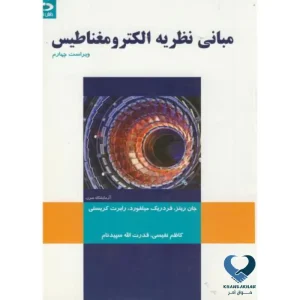


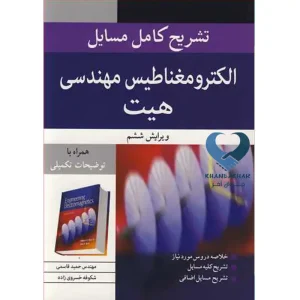
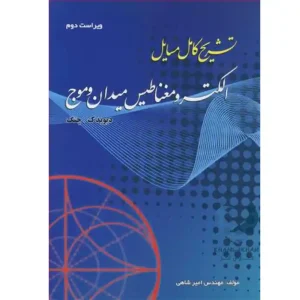

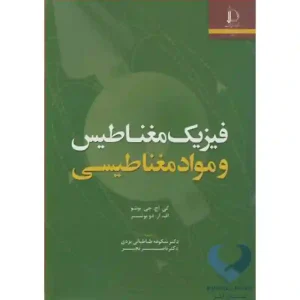

دیدگاهها
هیچ دیدگاهی برای این محصول نوشته نشده است.